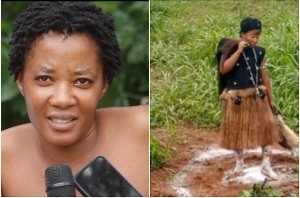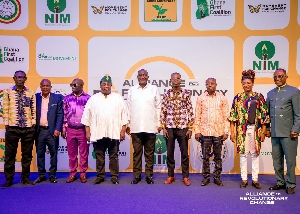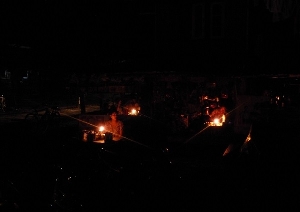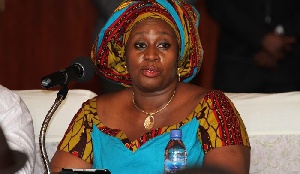 The Chief of Kumbungu, Kumbung Naa Abu Iddirisu
The Chief of Kumbungu, Kumbung Naa Abu Iddirisu
The warrior beehive of Dagbon was unveiled on Monday following the official declaration of the Chief of Kumbungu to attend the final funeral rites of the late Overlord of Dagbon Yaa Naa Yakubu Andani (II).
The Chief of Kumbungu, who is traditionally the army commander of Dagbon, has customary duties to perform during the funeral and one of the customs, according to Dagbon tradition is to unveil the beehive for an onward journey to Yendi.
Consequently, the Chief of Kumbungu Traditional Area, Alhaji Naa Abu Iddrisu (II) performed the first task of commanding the beehive contained in the traditional regalia called (Logu) with an anointed cow tail to respond to the customary duties, which they did to the admiration of elders, subchiefs and opinion leaders in the locality.
Following that, he began a four-day journey to the Dagbon traditional capital of Yendi on Monday (January 14, 2019) for the final funeral rites of the Late Overlord of Dagbon Ya- Na Yakubu Andani (II).
As custom and tradition demands, the Kumbungu chief (Kumbung-Naa), moved with the traditional bees (Logu) and a high powered delegation to Tamale as the first stop.
"Pregnant women must not be cited along the road when the Kumbung-Naa approaches" an elder abreast with the traditional values said prior to the journey.
He cautioned also cautioned that "all businesses along the Tamale-Kumbungu must remain closed...businesses on the ADB/ Commercial Bank road through to MTN office all the way to Kalpohini must be closed until the Kumbung-Naa and his warrior team passes" the warning notice served by traditional authorities had indicated.
This traditional exercise, according to many indigenes of the ancient town known for its conquering history only occurs when Dagbon is on its way to the final funeral rites of a Yaa Naa upon his demise. Aside that, the warrior bees located in Mba Naa Yili, the community housing the beehive, also guide the chiefs and people of Dagbon, led by the Kumbung Naa when they are going to war.
On Monday, the tumultuous journey of the warrior bees from Kumbungu, twelve miles away from Tamale got underway, and did not only bring social and commercial activities in the Tamale metropolis to an absolute halt, but compelled over thirty communities along the route of the journey to line up the principal streets to catch a glimpse of the entourage led by the chief warrior Kumbung Naa Abu Iddirisu.
Reports indicate that between the hours of 10 am and Midday Monday, the main route designated for the journey was awash with a crowd.

On Tuesday (Today) the same exercise will be repeated from Kalpohini estate where the warrior bees stopped on the previous day (Monday) to "Sara Junction" along the Nim Avenue road, from Tamale Teaching Hospital (TTH) through Vitting Barrier as the entourage continued the journey to Mion, another important town where most kings of Dagbon (Yaa Naa's) often occupy before ascending to the ultimate skin at Yendi.
The chief and his entourage, in the company of the warrior bees, will be based at Mion for two days before finally setting off to Yendi on Thursday, January 17, 2019.
"This tradition has not happened in over 40 years, according to the aged in the Dagbon traditional area. It only occurred after the performance of the final funeral rites of the last Yaa Naa who died on the throne"
Historically, Kumbungu paramountcy has been identified as one of the most peaceful traditional areas in Dagbon where the excesses of Abudu and Andani differences has been contained. The people in the community have maintained a healthy relationship existing between the two gates.
The farming area, many indigenes say, has enjoyed peaceful coexistence and continues to embrace peace and tranquility as a result of housing the most powerful deities in Dagbon such as the warrior bees known as Logu, the traditionally ordained peaceful snake known as Salim, and the humble lion known as Walima.
Dagombas, particularly the people of Kumbungu believe so much in these powerful deities that they often call on them to rescue them wherever they find themselves in danger and in terms of trouble, famine, or anxiety.
Under the circumstance, the traditional area will be playing an instrumental role before, during and after the installation of the new Yaa Naa for Dagbon.
- Ada Chief accused of defrauding his sub-chief
- Watch as youth of Abesim clash with executioners
- Sampa chieftaincy crisis: Two killed amid gunshots
- Mahama endorsement: Petition for destoolment of Ankobeahene of Begoro dismissed
- Jirapa Dubai CEO's murder connected to chieftaincy dispute
- Read all related articles












